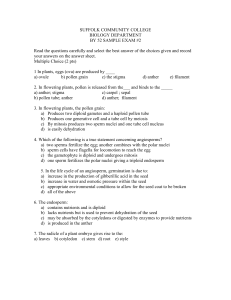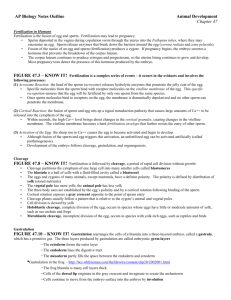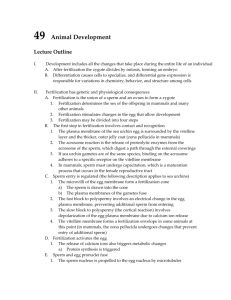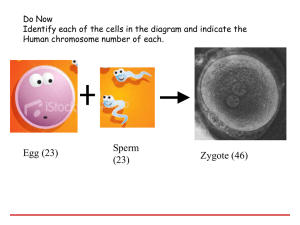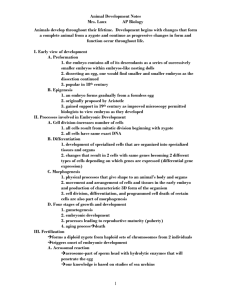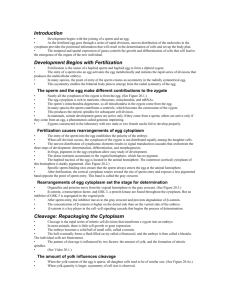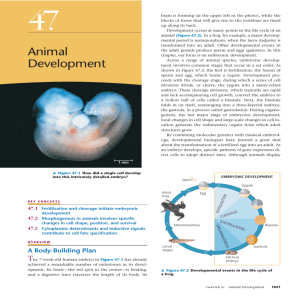Lab Exercises Part 1b: Embryology
advertisement
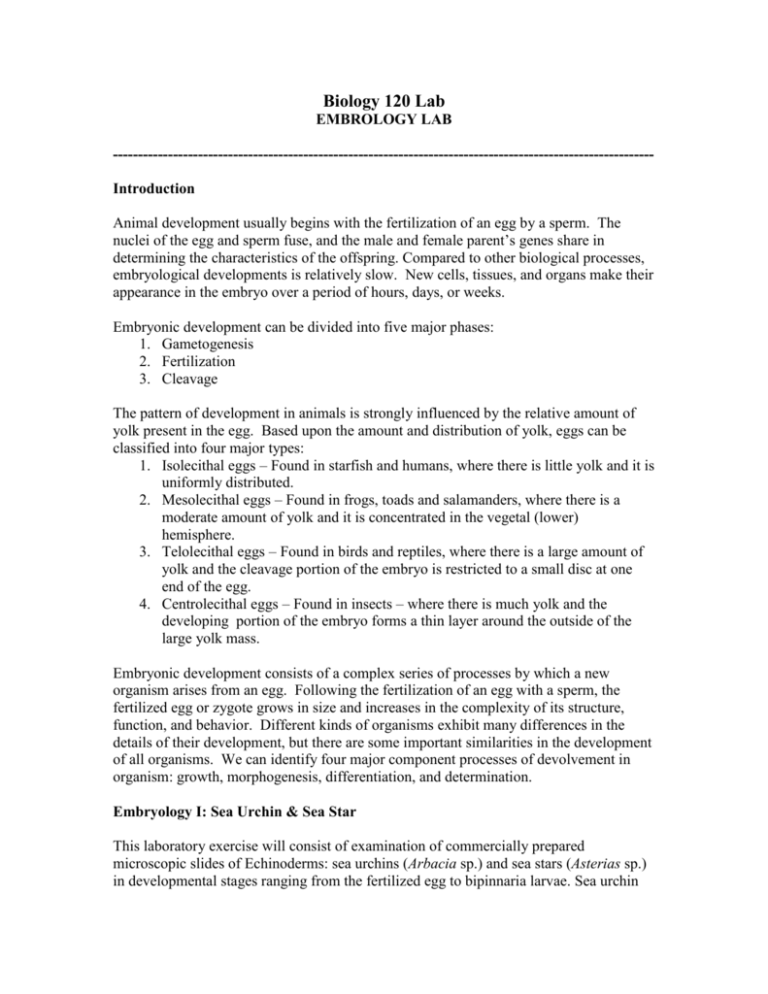
Biology 120 Lab EMBROLOGY LAB -----------------------------------------------------------------------------------------------------------Introduction Animal development usually begins with the fertilization of an egg by a sperm. The nuclei of the egg and sperm fuse, and the male and female parent’s genes share in determining the characteristics of the offspring. Compared to other biological processes, embryological developments is relatively slow. New cells, tissues, and organs make their appearance in the embryo over a period of hours, days, or weeks. Embryonic development can be divided into five major phases: 1. Gametogenesis 2. Fertilization 3. Cleavage The pattern of development in animals is strongly influenced by the relative amount of yolk present in the egg. Based upon the amount and distribution of yolk, eggs can be classified into four major types: 1. Isolecithal eggs – Found in starfish and humans, where there is little yolk and it is uniformly distributed. 2. Mesolecithal eggs – Found in frogs, toads and salamanders, where there is a moderate amount of yolk and it is concentrated in the vegetal (lower) hemisphere. 3. Telolecithal eggs – Found in birds and reptiles, where there is a large amount of yolk and the cleavage portion of the embryo is restricted to a small disc at one end of the egg. 4. Centrolecithal eggs – Found in insects – where there is much yolk and the developing portion of the embryo forms a thin layer around the outside of the large yolk mass. Embryonic development consists of a complex series of processes by which a new organism arises from an egg. Following the fertilization of an egg with a sperm, the fertilized egg or zygote grows in size and increases in the complexity of its structure, function, and behavior. Different kinds of organisms exhibit many differences in the details of their development, but there are some important similarities in the development of all organisms. We can identify four major component processes of devolvement in organism: growth, morphogenesis, differentiation, and determination. Embryology I: Sea Urchin & Sea Star This laboratory exercise will consist of examination of commercially prepared microscopic slides of Echinoderms: sea urchins (Arbacia sp.) and sea stars (Asterias sp.) in developmental stages ranging from the fertilized egg to bipinnaria larvae. Sea urchin and star fish are very similar in their development. The objectives are to identify developmental stages and make clear, labeled and scaled drawings of developmental stages found on the slides. Reference diagrams are included below to assist in identifying these stages, and are not to be simply copied. Draw what you see on the actual slides. Accurate labels on drawings are important. Remember, your drawings, labels and notes will be your best source of information for the final lab practicum. Refer to your lecture notes and text for supplementary illustrations and information. Additional reference material with illustrations may be available in books kept in our laboratory library collection. Sea urchins are a useful model system for studying many problems in early development. Historically, sea urchins were a key model system in elucidating a variety of classic developmental problems, including the mechanisms of fertilization and egg activation, cleavage, gastrulation, and the regulation of differentiation in the early embryo. In addition, early studies of the molecular basis of early development were carried out in this system. Gametes can be obtained easily, sterility is not required, and the eggs and early embryos of many commonly used species are beautifully transparent. In addition, the early development of sea urchin embryos is highly synchronous, i.e., when a batch of eggs is fertilized, all of the resulting embryos typically develop on the same time course. This makes biochemical and molecular studies of early embryos possible in this system, and has led to a number of major discoveries. Sea urchins have been a convenient system for studying fertilization and egg activation for a century. In fact, many of the key discoveries regarding species-specific sperm-egg binding and the signals that mediate the blocks to polypsermy and egg activation were made first in this system. The acrosome reaction is a change in the sperm that is common to many higher animals. In the sea urchin, contact with egg jelly initiates the acrosome reaction, which is a calcium-mediated process. In response to signals presumably transduced by receptors on the surface of the sperm that bind to components of egg jelly, actin polymerizes from a pool of globular actin to form the acrosomal process. The acrosomal vesicle fuses with the plasma membrane, releasing enzymes from the tip of the sperm that aid digestion of egg jelly. At the same time, bindin is deposited on the surface of the acrosome-reacted sperm. Once an acrosome reacted sperm comes in contact with the egg, a series of events are initiated that culminate in the union of the genetic material. We can separate these steps into (1) species-specific sperm-egg binding, (2) the fast block to polyspermy, (3) the slow block to polyspermy, (4) sperm incorporation, and (5) pronuclear migration and fusion. Sea urchins undergo radial cleavage, as do "typical" deuterstomes, such as chordates, ascidians, and other echinoderms. Like embryonic cleavages in other organisms, sea urchin cleavage divisions are reductive, i.e., the cleavages result in more cells, but without an increase in the total cellular volume of the embryo. The next few pages provide representative pictures of cleavage stage embryos, and discuss the mechanisms and consequences of cleavage in sea urchin embryos. Shown below are representative pictures of various cleavage stages in L. variegatus. Note that the first two cleavages are meridional, i.e. the cleavage furrow passes through the animal and vegetal poles. The next cleavage is equatorial, i.e., it passes through the embryo's midsection. The fourth cleavage is unequal L. variegatus zygotes, viewed from the side. A. 1-cell zygote. The fertilization envelope is visible as a large "halo" around the embryo. The arrow points to the site of sperm penetration. B. 2-cell. C. 8-cell. D. 16-cell. E. 32-cell. F. Hatched blastula (F is courtesy Dr. Chuck Ettensohn, Carnegie-Mellon Univ.). Embryology II: Frog This lab is a continuation of descriptive, early embryology of a deutersostome (mouth developing distant from the blastopore). In this case we study a representative amphibian (Rana spp.) of the chordates, closely related to echinoderms by way of similar early embryology—cleavage through early gastrulation. By late gastrula in the frog embryo, developmental patterns of echinoderms and chordates begin to diverge dramatically, due to the nature of the highly complex nervous system and bilateral symmetry characteristic of vertebrates.This suggests the two now distinct groups once shared a common ancestor that led very early (perhaps 500 mybp) to two separate evolutionary lineages, one (Phylum: Echinodermata) with radial symmetry and simple, diffuse nervous system, the other (Phylum: Chordata) with bilateral symmetry and highly developed, centralized nervous system. Today, you will be examining commercially prepared slides, comparing and contrasting all stages of early development of the frog—fertilized egg to neural tube—and making clear, labeled, scaled drawings, as in the previous exercise. Slides showing the ovary and testes of a frog are also available, along with preserved specimens of tadpoles and newly metamorphosed frogs. Make as many drawings of lab slides and specimens as time permits. A few supplemental illustrations have been included to help identify the developmental stages and regions within the embryos.




